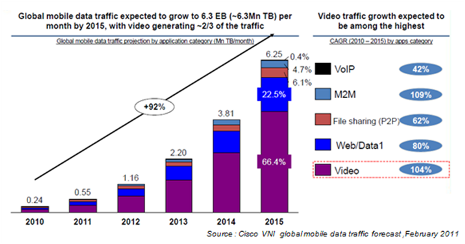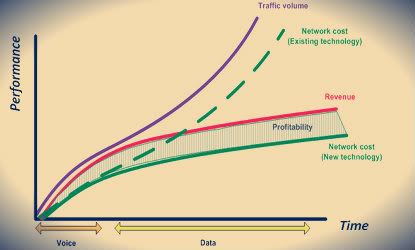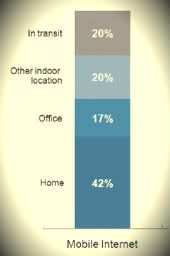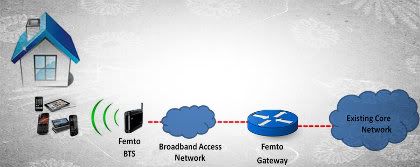Post by Iqbal Zulkarnain on Jul 10, 2012 15:59:01 GMT 7
[glow=red,2,300]Going to Small Cell[/glow]
Today, Internet is a rapidly growing market for multimedia services delivered to mobile devices, so called mobile internet. Mobile internet growth explosive on recent year. It affected by some factors as follows :
- Next generation services (interactive multimedia service, next generation messaging, mobile enterprise and cloud based data consumption)
- Smart multimedia devices with easy-to-use interfaces with IP enabled
- Unlimited bundled price packages from operators
- Rapid improvement in broadband technology (HSPA/LTE, MIMO, native IP, direct tunnel, etc)
From many factors above, mobile data traffic going exponentially, more than doubling annually and will be reach up to 6.3 exabytes per month by 2015.

Demand for data traffic seems good and will be potential income for operators. But in fact revenue growth not directly proportional with traffic growth.

Operators need to efficiently increase capacity to accommodate the enormous growth in mobile Internet traffic, and also increase network intelligence and performance to personalize and dynamically deliver new multimedia services to customers. New technologies are emerging help operators to increase profitability from the business. New technologies provide more efficient way to deliver data to customers, means with the same resource or bandwidth, more data delivered to customers. Network cost with new technologies will be more efficient due to higher capacity, lower power consumption, smaller footprint, multi run and also will be lower price in line with economic of scale of production.
Indoor Coverage is More Important Than Ever
Mobile data traffic gives significant growth year by year. Most of customers access the internet more often from indoor area. From 24 hour a day, customers access internet typically 9 hour a day in busy hour. Data traffic usage increase starting from 6.00 a.m where customers began their activity. From 6.00 a.m to 8.00 a.m typically customers began access internet on the go. When they had arrived at the office, they began uses data more often from 8.00 a.m to 17.00 p.m . Busy hour of usage typically happened in this period. After 17.00 to 20.00 p.m customers are on the go to home or hotspot area. From 20.00 to 23.00 p.m busy hour of usage can be happened again due to customers accessed internet from home/hotspot area.
If we take a look from customers data usage per day, typically peak data usage happened from indoor access.

source : Cisco IBSG Connected Life Market Watch, 2011
At work time or after office hour, customers usually uses internet from many hotspot area. Customers only uses internet on the go typically not more than three hours. Therefore 80% of traffic consumed from indoor area. That’s why mobile network operator should focusing data capacity from indoor area.
Why Small Cell ?
In line with rapid growth for mobile data explosion in the market, as a result, mobile operators are facing unprecedented challenges and opportunities. The challenge is mobile network operators have to deliver reliable and high throughput mobile services. Two primary factors are related to this challenge, economics and physics. Adding macro cell towers for improved coverage and capacity will be a significant capital and operational expense for mobile network operator. As we know from the figure, revenue does not scale linearly with the growth in consumption that requires massive capacity from the network. To guarantee healthy business results, operators need to find ways to dramatically lower the cost per delivered bit. Moreover, to guarantee high-speed data indoor, the radio signal must be delivered with high quality. Delivering high quality indoor from an outdoor antenna uses more power and spectrum resources than from an indoor antenna due to propagation loss caused as signals pass through walls and other building structures. In order to penetrate all walls, operators would have to increase signal power, which starts to cause interference between macro cell towers. Small cell/femtocell will provide a solution that delivers high-bandwidth applications to indoor locations from an indoor location, allowing the growth in bandwidth demand to be satisfied at dramatically lower costs, while improving mobility and coverage.
The Solution
Femtocell will deliver its advantage by originating the mobile signal indoor, overcoming the crucial signal-loss ratio from outdoor to indoor. Femtocell will reduce the distance traveled between the base station and the end-user device. At the same time, the femtocell architecture uses the residential broadband connection to backhaul all mobile traffic from the femtocell to the mobile core network, offloading the cellular network. This will be easier due to femtocell used IP connection on the backhaul. This advantage becomes increasingly important with the growth in bandwidth-hungry mobile data services such as streaming. Additional cost reductions can be expected as fewer new macro cell towers are required to meet growing bandwidth demand, reducing costs related to network equipment, site acquisition/leasing and power consumption.

femtocells possible to offer new services that will be only available when the users are located under the femtocell coverage. As femtocell standards are defined and finalized, standardized interfaces will allow application developers to create a host of new personalized applications that can take advantage of the unique attributes of femtocell. Two types of new services have been identified by the Femto Forum:
a. Femtozone Service
These services are correspond to standard mobile data/voice services but are triggered when the phone comes in range of the femtocell. Some examples are:
- Automatic profile switch when entering the home (for example, moving from business to personal services)
- SMS alert when a family member comes home
- Automatic upload/download of content when getting home (for example, getting programmed podcast downloaded to mobile handsets or uploading the latest pictures)
b. Connected Home Service
These Services will enable the femtocell system to locally route traffic within the home local network. This brings two additional benefits. First, it allows traffic offload from the mobile core network. Secondly, the mobile handset can then become a true component of the mobile home network, as described in the Connected Home standards (for example, a media player or media server as defined by Digital Living Network Alliance Universal Plug and Play [DLNA/UPnP]). Some examples of connected home services are:
- Backing up mobile hosted content (music, pictures) to the home PC or hard drive
- Playing videos/slide shows from the phone to another device on the home network
- Transforming the phone into a remote control for other devices on the network
For Customers, femtocell gives many benefits as follows :
a. Increased coverage and voice quality
b. Increased data speed
c. New innovative service plan will be created
d. Increased device battery life due to shorter distance to femtocell BTS
In addition, femtocell enable to offload traffic to WiFi vice versa. Since WiFi operate at unlicensed spectrum, WiFi only gives best effort data offload from the macro. For a femtocell, it can be network ubiquity for data access with stated QoS. Now, macrocell enable to offload traffic into WiFi for best effort data service or to femtocell with stated QoS from network.
As the challenge, femtocell will require innovative interference and mobility management. Since femtocell typically share macrocell spectrum it can be interference to macro or other femtos. It important to make planned femto deployment. Femto will be require mobility management for handover requirement between femto or femto with macro.
As a result, femtocell solution will accelerate mobile internet and gives operators a cost effective solution, means to extend high performance mobile indoor coverage to millions of subscribers, quickly and efficiently. A very small provisioning will reduces the time and cost of delivering new services. The use of femtocells will lower the operating expenses associated with RAN backhaul. End customers can enjoy the connected life at home or hotspot with reliable high-speed access to all their favorite applications, from a variety of devices throughout the home and hostpot area.
Author : Iqbal Zulkarnain
Today, Internet is a rapidly growing market for multimedia services delivered to mobile devices, so called mobile internet. Mobile internet growth explosive on recent year. It affected by some factors as follows :
- Next generation services (interactive multimedia service, next generation messaging, mobile enterprise and cloud based data consumption)
- Smart multimedia devices with easy-to-use interfaces with IP enabled
- Unlimited bundled price packages from operators
- Rapid improvement in broadband technology (HSPA/LTE, MIMO, native IP, direct tunnel, etc)
From many factors above, mobile data traffic going exponentially, more than doubling annually and will be reach up to 6.3 exabytes per month by 2015.

Demand for data traffic seems good and will be potential income for operators. But in fact revenue growth not directly proportional with traffic growth.

Operators need to efficiently increase capacity to accommodate the enormous growth in mobile Internet traffic, and also increase network intelligence and performance to personalize and dynamically deliver new multimedia services to customers. New technologies are emerging help operators to increase profitability from the business. New technologies provide more efficient way to deliver data to customers, means with the same resource or bandwidth, more data delivered to customers. Network cost with new technologies will be more efficient due to higher capacity, lower power consumption, smaller footprint, multi run and also will be lower price in line with economic of scale of production.
Indoor Coverage is More Important Than Ever
Mobile data traffic gives significant growth year by year. Most of customers access the internet more often from indoor area. From 24 hour a day, customers access internet typically 9 hour a day in busy hour. Data traffic usage increase starting from 6.00 a.m where customers began their activity. From 6.00 a.m to 8.00 a.m typically customers began access internet on the go. When they had arrived at the office, they began uses data more often from 8.00 a.m to 17.00 p.m . Busy hour of usage typically happened in this period. After 17.00 to 20.00 p.m customers are on the go to home or hotspot area. From 20.00 to 23.00 p.m busy hour of usage can be happened again due to customers accessed internet from home/hotspot area.
If we take a look from customers data usage per day, typically peak data usage happened from indoor access.

source : Cisco IBSG Connected Life Market Watch, 2011
At work time or after office hour, customers usually uses internet from many hotspot area. Customers only uses internet on the go typically not more than three hours. Therefore 80% of traffic consumed from indoor area. That’s why mobile network operator should focusing data capacity from indoor area.
Why Small Cell ?
In line with rapid growth for mobile data explosion in the market, as a result, mobile operators are facing unprecedented challenges and opportunities. The challenge is mobile network operators have to deliver reliable and high throughput mobile services. Two primary factors are related to this challenge, economics and physics. Adding macro cell towers for improved coverage and capacity will be a significant capital and operational expense for mobile network operator. As we know from the figure, revenue does not scale linearly with the growth in consumption that requires massive capacity from the network. To guarantee healthy business results, operators need to find ways to dramatically lower the cost per delivered bit. Moreover, to guarantee high-speed data indoor, the radio signal must be delivered with high quality. Delivering high quality indoor from an outdoor antenna uses more power and spectrum resources than from an indoor antenna due to propagation loss caused as signals pass through walls and other building structures. In order to penetrate all walls, operators would have to increase signal power, which starts to cause interference between macro cell towers. Small cell/femtocell will provide a solution that delivers high-bandwidth applications to indoor locations from an indoor location, allowing the growth in bandwidth demand to be satisfied at dramatically lower costs, while improving mobility and coverage.
The Solution
Femtocell will deliver its advantage by originating the mobile signal indoor, overcoming the crucial signal-loss ratio from outdoor to indoor. Femtocell will reduce the distance traveled between the base station and the end-user device. At the same time, the femtocell architecture uses the residential broadband connection to backhaul all mobile traffic from the femtocell to the mobile core network, offloading the cellular network. This will be easier due to femtocell used IP connection on the backhaul. This advantage becomes increasingly important with the growth in bandwidth-hungry mobile data services such as streaming. Additional cost reductions can be expected as fewer new macro cell towers are required to meet growing bandwidth demand, reducing costs related to network equipment, site acquisition/leasing and power consumption.

femtocells possible to offer new services that will be only available when the users are located under the femtocell coverage. As femtocell standards are defined and finalized, standardized interfaces will allow application developers to create a host of new personalized applications that can take advantage of the unique attributes of femtocell. Two types of new services have been identified by the Femto Forum:
a. Femtozone Service
These services are correspond to standard mobile data/voice services but are triggered when the phone comes in range of the femtocell. Some examples are:
- Automatic profile switch when entering the home (for example, moving from business to personal services)
- SMS alert when a family member comes home
- Automatic upload/download of content when getting home (for example, getting programmed podcast downloaded to mobile handsets or uploading the latest pictures)
b. Connected Home Service
These Services will enable the femtocell system to locally route traffic within the home local network. This brings two additional benefits. First, it allows traffic offload from the mobile core network. Secondly, the mobile handset can then become a true component of the mobile home network, as described in the Connected Home standards (for example, a media player or media server as defined by Digital Living Network Alliance Universal Plug and Play [DLNA/UPnP]). Some examples of connected home services are:
- Backing up mobile hosted content (music, pictures) to the home PC or hard drive
- Playing videos/slide shows from the phone to another device on the home network
- Transforming the phone into a remote control for other devices on the network
For Customers, femtocell gives many benefits as follows :
a. Increased coverage and voice quality
b. Increased data speed
c. New innovative service plan will be created
d. Increased device battery life due to shorter distance to femtocell BTS
In addition, femtocell enable to offload traffic to WiFi vice versa. Since WiFi operate at unlicensed spectrum, WiFi only gives best effort data offload from the macro. For a femtocell, it can be network ubiquity for data access with stated QoS. Now, macrocell enable to offload traffic into WiFi for best effort data service or to femtocell with stated QoS from network.
As the challenge, femtocell will require innovative interference and mobility management. Since femtocell typically share macrocell spectrum it can be interference to macro or other femtos. It important to make planned femto deployment. Femto will be require mobility management for handover requirement between femto or femto with macro.
As a result, femtocell solution will accelerate mobile internet and gives operators a cost effective solution, means to extend high performance mobile indoor coverage to millions of subscribers, quickly and efficiently. A very small provisioning will reduces the time and cost of delivering new services. The use of femtocells will lower the operating expenses associated with RAN backhaul. End customers can enjoy the connected life at home or hotspot with reliable high-speed access to all their favorite applications, from a variety of devices throughout the home and hostpot area.
Author : Iqbal Zulkarnain
